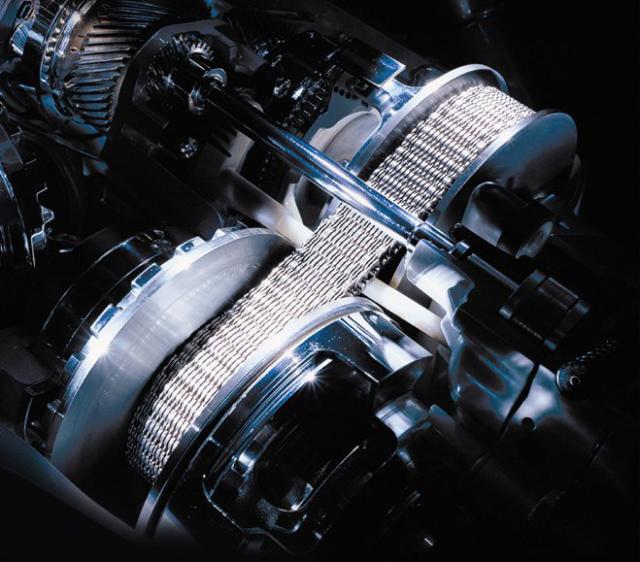Pros: Above-average fuel economy; simple, efficient power delivery; you’ll never feel a shift.
Cons: Takes some getting used to; can cause engine to drone during hard acceleration.
How the CVT works
Conventional automatic transmissions use a set of gears that provides a given number of ratios (or speeds). The transmission shifts gears to provide the most appropriate ratio for a given situation: Lowest gears for starting out, middle gears for acceleration and passing, and higher gears for fuel-efficient cruising.
The CVT replaces the gears with two variable-diameter pulleys, each shaped like a pair of opposing cones, with a metal belt or chain running between them. One pulley is connected to the engine (input shaft) and the other to the drive wheels (output shaft). The halves of each pulley are movable; as the pulley halves come closer together the belt is forced to ride higher on the pulley, effectively making the pulley’s diameter larger.
Changing the diameter of the pulleys varies the transmission’s ratio (the number of times the output shaft spins for each revolution of the engine), in the same way that a 10-speed bike routes the chain over larger or smaller gears to change the ratio. Making the input pulley smaller and the output pulley larger gives a low ratio (a large number of engine revolutions producing a small number of output revolutions) for better low-speed acceleration. As the car accelerates, the pulleys vary their diameter to lower the engine speed as car speed rises. This is the same thing a conventional transmission does, but instead of changing the ratio in stages by shifting gears, the CVT continuously varies the ratio — hence its name.
Driving a car with a CVT
The controls for a CVT are the same as an automatic: Two pedals (accelerator and brake) and a P-R-N-D-L-style shift pattern. When driving a car with a CVT, you won’t hear or feel the transmission shift — it simply raises and lowers the engine speed as needed, calling up higher engine speeds (or RPMs) for better acceleration and lower RPMs for better fuel economy while cruising.
Many people find the CVT disconcerting at first because of the way cars with CVTs sound. When you step hard on the accelerator, the engine races as it would with a slipping clutch or a failing automatic transmission. This is normal — the CVT is adjusting the engine speed to provide optimal power for acceleration. Some CVTs are programmed to change ratios in steps, so that they feel more like a conventional automatic transmission.
Advantages of the CVT
Engines do not develop constant power at all speeds; they have specific speeds where torque (pulling power), horsepower (speed power) or fuel efficiency are at their highest levels. Because there are no gears to tie a given road speed directly to a given engine speed, the CVT can vary the engine speed as needed to access maximum power as well as maximum fuel efficiency. This allows the CVT to provide quicker acceleration than a conventional automatic or manual transmission while delivering superior fuel economy.
Disadvantages of the CVT
The CVT’s biggest problem has been user acceptance. Because the CVT allows the engine to rev at any speed, the noises coming from under the hood sound odd to ears accustomed to conventional manual and automatic transmissions. The gradual changes in engine note sound like a sliding transmission or a slipping clutch — signs of trouble with a conventional transmission, but perfectly normal for a CVT. Flooring an automatic car brings a lurch and a sudden burst of power, whereas CVTs provide a smooth, rapid increase to maximum power. To some drivers this makes the car feel slower; in fact a CVT will generally out-accelerate an automatic.
Automakers have gone to great lengths to make the CVT feel more like a conventional transmission. Many CVTs are programmed to simulate the “kick-down” feel of a regular automatic when the pedal is floored. Some CVTs offer a “manual” mode with steering-wheel-mounted paddle shifters that allows the CVT to simulate a conventional stepped transmission.
Because early automotive CVTs were limited as to how much horsepower they could handle, there has been some concern about the long-term reliability of the CVT. Advanced technology has made the CVT much more robust. Nissan has more than a million CVTs in service around the world and says their long-term reliability is comparable to conventional transmissions.
Power split: The CVT that isn’t a CVT
Several hybrids, including the Toyota Prius family, use a type of transmission called a power-split transmission. While the power split feels like a CVT, it does not use the belt-and-pulley arrangement; instead, it uses a planetary gearset with both a gasoline engine and electric motor providing inputs. By varying the speed of the electric motor, the speed of the gasoline engine is also varied, allowing the gas engine to either run at a constant speed as the car accelerates, or to stop completely.








